Children's social work statistics: 2019 to 2020
Children's social work statistics for Scotland for 2019 to 2020, including data on children and young people looked after, on the child protection register and in secure care.
This document is part of a collection
Child Protection
Number of children on the child protection register increased by 3%, but is lower than the peak in 2014
There was a decrease in the number of child protection registrations and deregistrations in the last year, by 8% and 9% respectively
Most common causes for concern were emotional and domestic abuse, parental substance misuse, and neglect
This section presents data on children on the child protection register from 1 August 2019 to 31 July 2020. This will be referred to as 2020 for ease of reporting (with 2018-19 referred to as 2019 and so on). Child protection means protecting a child from abuse or neglect. This can either be in cases where abuse or neglect has taken place, or in cases where a likelihood of significant harm or neglect has been identified. The risk of harm or neglect is considered at a Child Protection Case Conference. Where a child is believed to be at risk of significant harm, their name will be added to the child protection register (a child protection registration).
This was the eighth year that child protection data has been collected entirely at individual level.
Children on the child protection register
The number of children on the child protection register increased from 2,580 in 2019 to 2,654 in 2020 (a 3% increase). There was a general upward trend in the number of children on the child protection register, until 2014 when the number peaked at 2,877. However, the number on the register then reduced in each of the next four years, before rising again slightly in 2019 and 2020.
As is usual, the number of children on the register in 2020 will be revised in next year's publication, as updated information is received from local authorities. This report includes revised figures in 2019 for all local authorities.
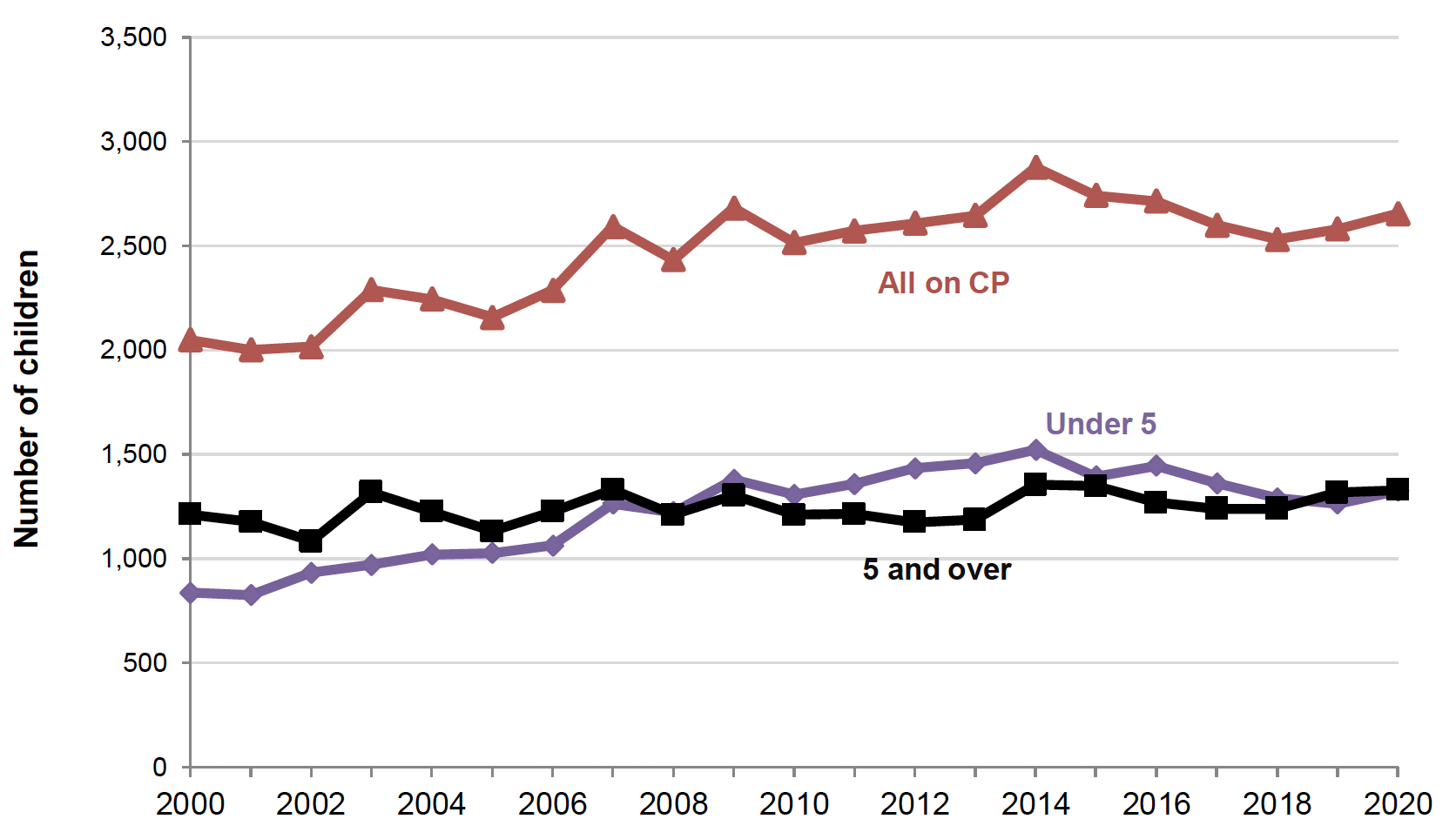
Between 2008 and 2018, there were more children aged under five than five or over on the child protection register. This changed in 2019, with just over half of children being aged five or over. In 2020, again around half of children on the child protection register were aged under five (1,325) and half were 5 or over (1,329).
There is no strong gender pattern among children on the child protection register – 47% were boys, 48% were girls, and 5% were unborn (Table 2.1). Because of a change in how unborn children were recorded by local authorities in 2010, figures for unborn children are only comparable from 2011 onwards.
| Number | Percentage | |||||
|---|---|---|---|---|---|---|
| 2011 | 2019 | 2020 | 2011 | 2019 | 2020 | |
| Male | 1,282 | 1,358 | 1,260 | 50% | 53% | 47% |
| Female | 1,209 | 1,224 | 1,271 | 47% | 47% | 48% |
| Unborns | 80 | 97 | 123 | 3% | 4% | 5% |
| All Children | 2,571 | 2,580 | 2,654 | 100% | 100% | 100% |
(1) Unborn children include both unborn children with a known gender and those with an unknown gender. Those with a known gender are not included in the boys or girls categories in this table.
At child protection case conferences, multiple concerns can be recorded (rather than just the main category of concern). This means that the total number of concerns is larger than the total number of registrations. For the 2,654 children on the child protection register at 31 July 2020, there were 7,315 concerns at the case conferences at which they were registered – an average of 2.8 concerns per conference. Chart 6 below shows the most common concerns identified were domestic (1,132) and emotional (1,028) abuse, neglect (1,112), and parental substance misuse (1,135). The parental substance misuse category is further broken down by the type of substance misused. Alcohol misuse only was identified as a concern in 333 conferences, drug misuse only in 536 conferences and both in 266 conferences. Figures are shown in full in Additional Table 4.3.
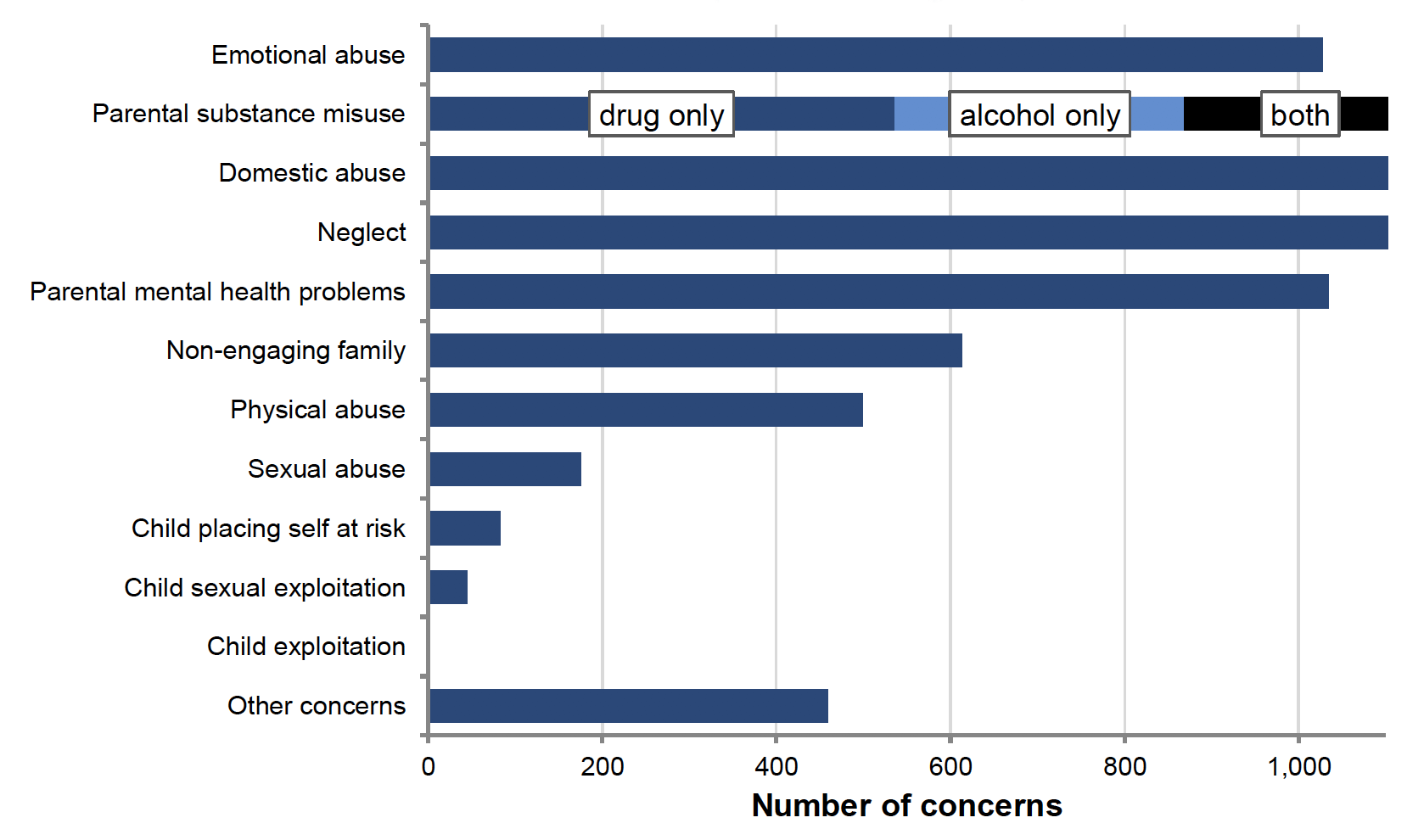
Child protection registrations and deregistrations
The number of registrations to the child protection register decreased by 8% between 2019 and 2020. The proportion of children registered who had never been registered before stayed at 80% in 2020 (Table 2.2). The remaining 20% of registrations on the child protection register were for children who had been registered previously. The largest group of these children was those who had been previously registered 2 years ago or more, with this group making up 11% of all registrations in 2020.
| Number | Percentage | |||||
|---|---|---|---|---|---|---|
| Time since last deregistration | 2010 | 2019 | 2020 | 2010 | 2019 | 2020 |
| Never been registered before | 2,971 | 3,427 | 3,163 | 84% | 80% | 80% |
| Registered before but time unknown | 0 | 0 | 0 | 0% | 0% | 0% |
| Less than 6 months | 81 | 99 | 104 | 2% | 2% | 3% |
| 6 months - < 1 year | 98 | 104 | 81 | 3% | 2% | 2% |
| 1 year - < 18 months | 67 | 107 | 89 | 2% | 2% | 2% |
| 18 months - < 2 years | 60 | 96 | 59 | 2% | 2% | 1% |
| 2 years or more | 269 | 456 | 446 | 8% | 11% | 11% |
| Not known if been registered before | 5 | 6 | 15 | 0% | 0% | 0% |
| Total | 3,551 | 4,295 | 3,957 | 100% | 100% | 100% |
(1) This is calculated as a proportion of registrations excluding cases where it is not known if a child had been registered before.
Table 2.3 shows the numbers of deregistrations from the child protection register, by length of time registered and reason for deregistration. There were 3,879 deregistrations from the child protection register in the year to 31 July 2020, a 9% decrease from the 4,245 recorded in 2019. The most common reason for deregistration in 2020 was an improved home situation, recorded in 53% of cases. In almost half (48%) of deregistrations, the child had been on the child protection register for less than 6 months, and in 86% of cases for less than one year.
| Number | Percentage | |||||
|---|---|---|---|---|---|---|
| Time since last deregistration | 2010 | 2019 | 2020 | 2010 | 2019 | 2020 |
| Length of time registered | ||||||
| Less than 6 months | 1,592 | 2,149 | 1,856 | 42% | 51% | 48% |
| 6 months to under 1 year | 1,483 | 1,551 | 1,464 | 39% | 37% | 38% |
| 1 year to under 18 months | 460 | 356 | 362 | 12% | 8% | 9% |
| 18 months to under 2 years | 168 | 103 | 101 | 4% | 2% | 3% |
| 2 years or more | 123 | 43 | 55 | 3% | 1% | 1% |
| No date of registration information | 0 | 43 | 41 | 0% | 1% | 1% |
| Reason for deregistration | 0 | 0 | ||||
| Child taken into care & risk reduced | 538 | 500 | 465 | 14% | 12% | 12% |
| Child with other carers | 275 | 307 | 312 | 7% | 7% | 8% |
| Child died | * | 11 | 9 | * | 0% | 0% |
| Removal of perpetrator | 81 | 144 | 123 | 2% | 3% | 3% |
| Improved home situation | 1,220 | 2,227 | 2,074 | 32% | 52% | 53% |
| Child automatically deregistered because of age | 8 | 12 | 6 | 0% | 0% | 0% |
| Child moved away - no continued risk | 26 | 37 | 30 | 1% | 1% | 1% |
| Other reason | 1,674 | 1,007 | 860 | 44% | 24% | 22% |
| Reason not known | 0 | 0 | 0 | 0% | 100% | 0% |
| Total | 3,822 | 4,245 | 3,879 | 100% | 100% | 100% |
(1) Includes where a child transferred to another local authority and where reason has not been recorded.
Charts 6a and 6b show the number of children being registered on and deregistered from the child protection register in each of the last two years by month. While the number of deregistrations relative to the number of registrations has fluctuated across each of the last two years, and the patterns are broadly similar in each year, the number of deregistrations reached its lowest level over the two years in April 2020 at 225. The second lowest level of deregistrations over the two year period was recorded in July 2020.
In 2019-20, the numbers of registrations and deregistrations were lower than in 2018-19 in the period August to March (prior to the COVID-19 pandemic) by 9% and 7% respectively. For the remainder of the year, the numbers were lower than in the equivalent period the previous year by 5% and 13%.
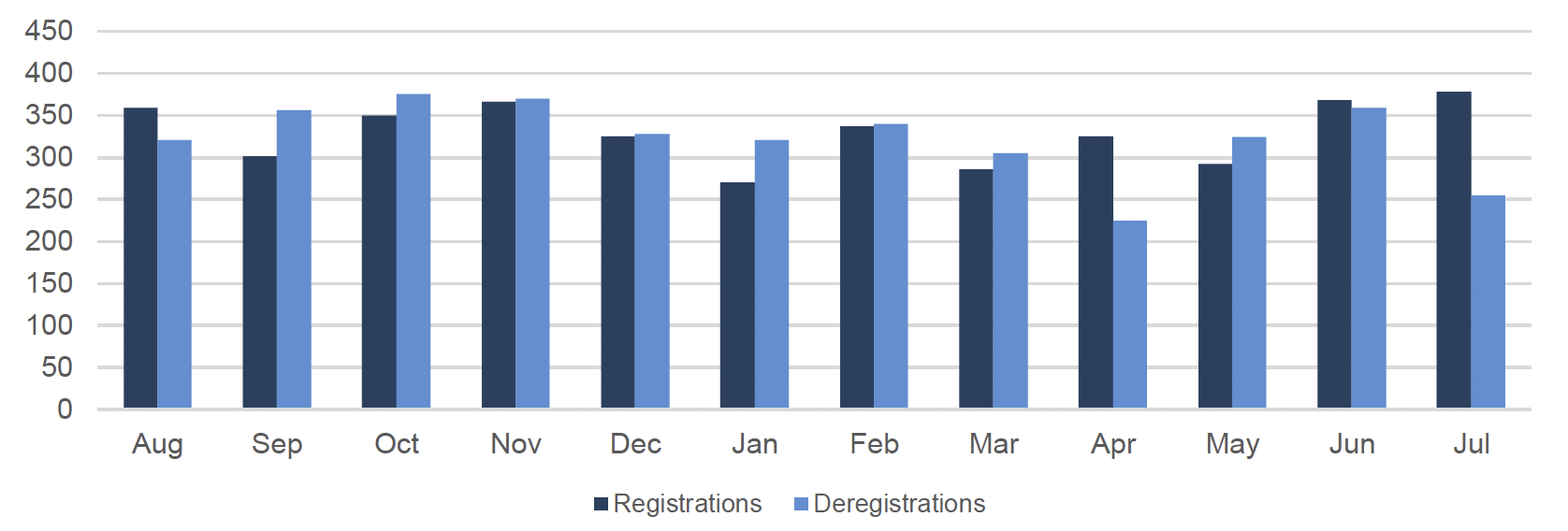

Chart 7 shows that, since 2015, the percentage of deregistrations of children who spent less than six months on the child protection register increased each year till 2019, peaking at 51%. The current figure has fallen back to 48% of deregistrations in 2019-20. There has been a corresponding increase in the last year in the proportion of deregistrations for children who spent 6 months or more on the child protection register, with 38% of deregistrations in 2019-20 being of children who spent between 6 months and a year on the child protection register.
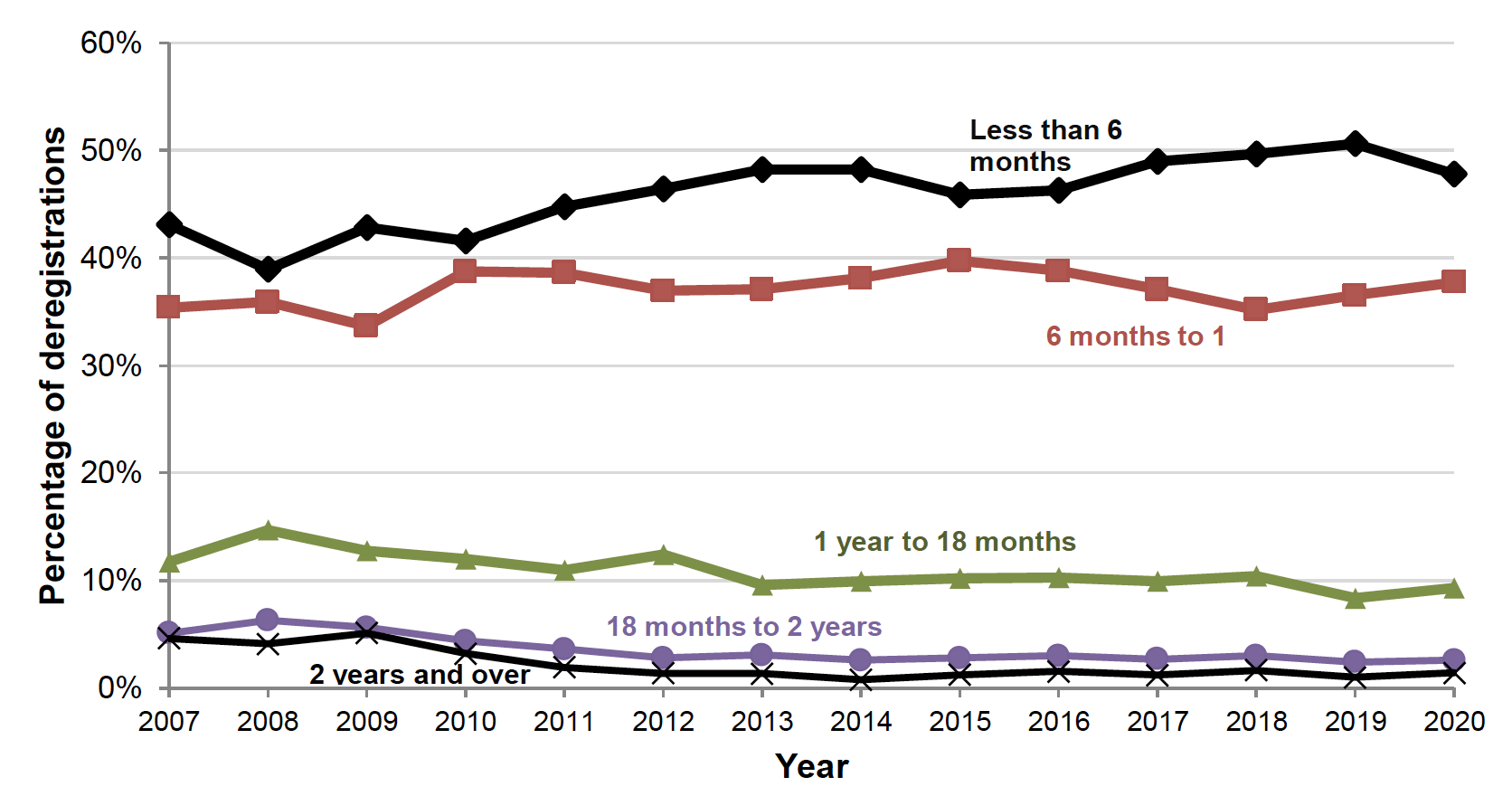
Child Protection Register Geographical Comparisons
Number on the register within Scotland
Table 2.4 shows the number and rate of children under 16 who were on the child protection register in Scotland in July 2020 by local authority. The rate varied from 0.5 per 1,000 children in the East Renfrewshire to 6.1 per 1,000 children in North Ayrshire.
There is a lot of variability from year to year in the numbers of children on the child protection register at a local authority level due to the small numbers of children involved in each local authority.
|
|
2010 | 2019 | 2020 | |||
|---|---|---|---|---|---|---|
| Local authority | Number on Register | Rate(1,2) | Number on Register | Rate(1,2) | Number on Register | Rate(1,2) |
| Aberdeen City | 119 | 3.7 | 119 | 3.4 | 142 | 4.0 |
| Aberdeenshire | 51 | 1.1 | 103 | 2.1 | 111 | 2.3 |
| Angus | 92 | 4.5 | 45 | 2.4 | 36 | 1.9 |
| Argyll and Bute | 43 | 2.9 | 28 | 2.2 | 49 | 3.8 |
| City of Edinburgh | 256 | 3.6 | 122 | 1.5 | 95 | 1.2 |
| Clackmannanshire | 56 | 5.9 | 24 | 2.7 | 41 | 4.6 |
| Dumfries and Galloway | 100 | 3.9 | 18 | 0.8 | 26 | 1.1 |
| Dundee City | 70 | 2.9 | 90 | 3.7 | 102 | 4.2 |
| East Ayrshire | 42 | 1.9 | 100 | 4.7 | 78 | 3.7 |
| East Dunbartonshire | 28 | 1.5 | 55 | 2.8 | 37 | 1.9 |
| East Lothian | 70 | 3.8 | 48 | 2.4 | 52 | 2.6 |
| East Renfrewshire | 31 | 1.7 | 15 | 0.8 | 9 | 0.5 |
| Falkirk | 73 | 2.6 | 124 | 4.4 | 142 | 5.1 |
| Fife | 220 | 3.4 | 205 | 3.2 | 147 | 2.3 |
| Glasgow City | 286 | 3.0 | 415 | 4.1 | 420 | 4.2 |
| Highland | 99 | 2.4 | 91 | 2.3 | 129 | 3.3 |
| Inverclyde | 35 | 2.5 | 47 | 3.7 | 61 | 4.8 |
| Midlothian | 96 | 6.2 | 49 | 2.7 | 49 | 2.7 |
| Moray | 44 | 2.6 | 47 | 2.9 | 31 | 1.9 |
| Na h-Eileanan Siar | * | * | * | * | * | * |
| North Ayrshire | 60 | 2.4 | 104 | 4.6 | 137 | 6.1 |
| North Lanarkshire | 63 | 1.0 | 162 | 2.6 | 118 | 1.9 |
| Orkney Islands | * | * | * | * | 10 | 2.8 |
| Perth and Kinross | 49 | 1.9 | 78 | 3.2 | 95 | 3.9 |
| Renfrewshire | 119 | 3.9 | 83 | 2.7 | 98 | 3.2 |
| Scottish Borders | 32 | 1.6 | 46 | 2.4 | 34 | 1.8 |
| Shetland Islands | 10 | 2.2 | 12 | 2.9 | * | * |
| South Ayrshire | 43 | 2.3 | 37 | 2.1 | 29 | 1.6 |
| South Lanarkshire | 135 | 2.4 | 116 | 2.1 | 160 | 2.9 |
| Stirling | 43 | 2.7 | 42 | 2.7 | 46 | 3.0 |
| West Dunbartonshire | 27 | 1.6 | 44 | 2.8 | 66 | 4.2 |
| West Lothian | 119 | 3.4 | 104 | 2.9 | 92 | 2.6 |
| Scotland | 2,518 | 2.7 | 2,580 | 2.8 | 2,654 | 2.9 |
(1) Per 1,000 population aged 0-15. Source: National Records of Scotland, 2007-2019 mid-year population estimates
(2) The rate shown in this table includes unborn children who are on the register
Number of child protection investigations within Scotland
A child protection investigation is a joint[4] investigation launched following an Inter-agency Referral Discussion in order to determine if any child protection action is needed and whether a child protection case conference should be held.
Data on child protection investigations has been published for the first time in Table 2.5. The rate of child protection investigations varied from 1.2 in East Renfrewshire to 39.7 per 1,000 children in Clackmannanshire.
The number of initial and pre-birth child protection case conferences and registrations from these is also shown; for those with an investigation recorded within 90 days prior to case conference, the child's progression through the child protection process from investigation to case conference and potentially registration can be followed.
However, there were 733 out of 4,978 total initial and pre-birth case conferences where no investigation was recorded within 90 days prior to case conference; this suggests that the investigations for these conferences may be missing from the figures shown. There may be other legitimate reasons for the investigation not being within 90 days prior to case conference.
| Child protection investigations | Child protection initial and pre-birth case conferences | Child protection registrations from initial and pre-birth case conferences | ||||||||
|---|---|---|---|---|---|---|---|---|---|---|
| Local authority | Number(3) | Rate(2) | Number with an investigation recorded within 90 days of case conference | Number with no investigation recorded within 90 days of case conference(4) | Total | Rate(2) | Number with an investigation recorded within 90 days of case conference | Number with no investigation recorded within 90 days of case conference(3) | Total | Rate(2) |
| Aberdeen City | 269 | 7.6 | 183 | 3 | 186 | 5.3 | 156 | 3 | 159 | 4.5 |
| Aberdeenshire | 408 | 8.3 | 144 | 14 | 158 | 3.2 | 134 | 13 | 147 | 3.0 |
| Angus | 266 | 13.9 | 50 | 70 | 120 | 6.3 | 38 | 62 | 100 | 5.2 |
| Argyll and Bute | 114 | 8.8 | 39 | 36 | 75 | 5.8 | 38 | 29 | 67 | 5.2 |
| City of Edinburgh | 1,026 | 13.0 | 159 | 30 | 189 | 2.4 | 143 | 26 | 169 | 2.1 |
| Clackmannanshire | 355 | 39.7 | 70 | 37 | 107 | 12.0 | 47 | 22 | 69 | 7.7 |
| Dumfries and Galloway | 383 | 16.5 | 57 | 11 | 68 | 2.9 | 32 | 9 | 41 | 1.8 |
| Dundee City | 698 | 29.0 | 128 | 29 | 157 | 6.5 | 127 | 29 | 156 | 6.5 |
| East Ayrshire | 384 | 18.2 | 211 | 15 | 226 | 10.7 | 139 | 8 | 147 | 7.0 |
| East Dunbartonshire | 170 | 8.8 | 79 | 8 | 87 | 4.5 | 40 | 7 | 47 | 2.4 |
| East Lothian | 360 | 18.3 | 55 | 14 | 69 | 3.5 | 50 | 9 | 59 | 3.0 |
| East Renfrewshire | 23 | 1.2 | 20 | 0 | 20 | 1.0 | 19 | 0 | 19 | 1.0 |
| Falkirk | 459 | 16.3 | 181 | 8 | 189 | 6.7 | 150 | 5 | 155 | 5.5 |
| Fife | 892 | 13.8 | 317 | 1 | 318 | 4.9 | 282 | 1 | 283 | 4.4 |
| Glasgow City | 1,740 | 17.3 | 654 | 3 | 657 | 6.5 | 449 | 2 | 451 | 4.5 |
| Highland | 412 | 10.6 | 22 | 145 | 167 | 4.3 | 20 | 136 | 156 | 4.0 |
| Inverclyde | 125 | 9.9 | 94 | 28 | 122 | 9.7 | 76 | 19 | 95 | 7.5 |
| Midlothian | 567 | 31.6 | 92 | 20 | 112 | 6.2 | 76 | 18 | 94 | 5.2 |
| Moray | 240 | 14.9 | 27 | 23 | 50 | 3.1 | 23 | 17 | 40 | 2.5 |
| Na h-Eileanan Siar | 15 | 3.5 | 3 | 23 | 26 | 6.1 | 1 | 8 | 9 | 2.1 |
| North Ayrshire | 430 | 19.1 | 295 | 1 | 296 | 13.2 | 243 | 1 | 244 | 10.9 |
| North Lanarkshire | 720 | 11.5 | 271 | 15 | 286 | 4.6 | 208 | 10 | 218 | 3.5 |
| Orkney Islands | 67 | 18.7 | 13 | 1 | 14 | 3.9 | 10 | 1 | 11 | 3.1 |
| Perth and Kinross | 303 | 12.4 | 112 | 16 | 128 | 5.2 | 102 | 15 | 117 | 4.8 |
| Renfrewshire | 405 | 13.4 | 224 | 1 | 225 | 7.4 | 136 | 0 | 136 | 4.5 |
| Scottish Borders | 118 | 6.2 | 39 | 5 | 44 | 2.3 | 32 | 5 | 37 | 1.9 |
| Shetland Islands | 96 | 22.9 | 10 | 5 | 15 | 3.6 | 8 | 3 | 11 | 2.6 |
| South Ayrshire | 157 | 8.9 | 63 | 0 | 63 | 3.6 | 46 | 0 | 46 | 2.6 |
| South Lanarkshire | 699 | 12.6 | 366 | 35 | 401 | 7.2 | 252 | 23 | 275 | 4.9 |
| Stirling | 100 | 6.5 | 0 | 52 | 52 | 3.4 | 0 | 50 | 50 | 3.2 |
| West Dunbartonshire | 241 | 15.4 | 114 | 29 | 143 | 9.1 | 72 | 6 | 78 | 5.0 |
| West Lothian | 692 | 19.5 | 153 | 55 | 208 | 5.9 | 114 | 49 | 163 | 4.6 |
| Scotland | 12,934 | 14.0 | 4,245 | 733 | 4,978 | 5.4 | 3,263 | 586 | 3,849 | 4.2 |
(1) Per 1,000 population aged 0-15. Source: National Records of Scotland, mid-year 2019 population estimates.
(2) The rate shown in this table includes unborn children who are on the register
(3) Includes 135 child protection investigations that took place prior to 1 August 2019 (in 2018-19) where the resulting case conference took place on or after 1 August 2019 (in 2019-20).
(4) Case conferences with no investigation recorded within 90 days are cases where no investigation was recorded in the data provided to Scottish Government in the 90 days preceding the case conference.
Cross-UK child protection comparisons
Child protection systems across the United Kingdom vary but are generally comparable. Scotland's data collection year runs from 1 August to 31 July, so end‑year figures are typically reported at 31 July in this publication, while the collection year in England, Wales and Northern Ireland runs from 1 April to 31 March (so end-year figures are at 31 March). In Chart 8, we report the Scotland figures at the 31st March to allow better comparison with the other countries.
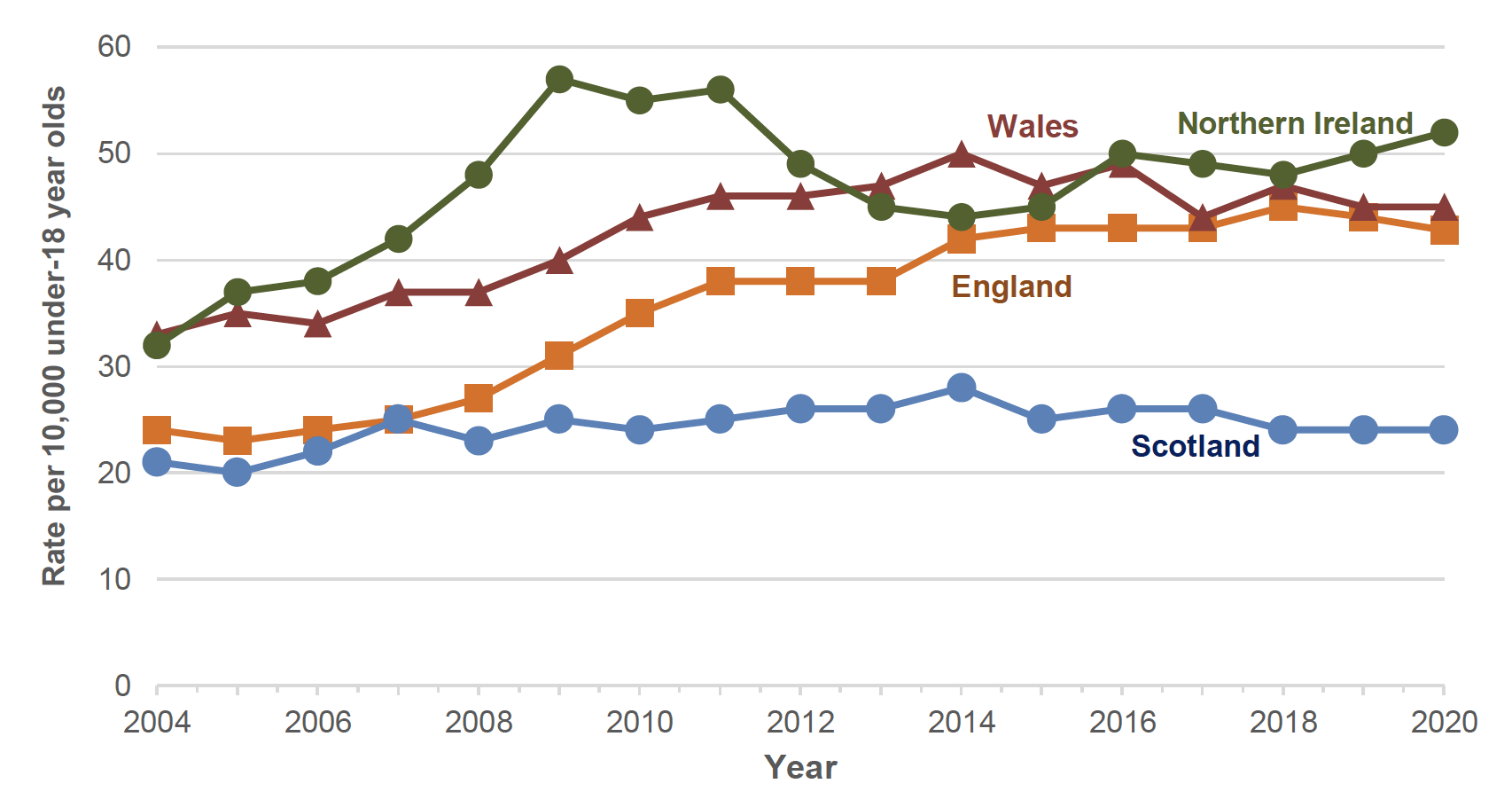
The proportion of children on the child protection register has been broadly stable in Scotland over the last decade and this proportion is notably lower compared with the rest of the UK. Scotland did not experience the large increases in children on the register in 2007-2011 as seen in the rest of the UK. There is more information on the comparability of child protection data across the UK on the Scottish Government website.
The data used to produce the charts and tables on child protection in the publication are available in the supporting files accompanying the publication. There are also additional tables available in the supporting files.
Contact
There is a problem
Thanks for your feedback